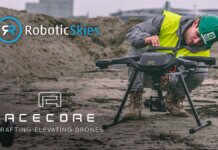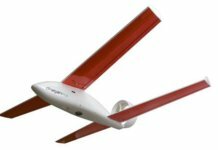On May 5, a Nevada UAS Consortium, Team Roadrunner, flew a package-equipped, fixed-wing unmanned aerial vehicle (UAV) more than 97 miles to Austin, Texas, using cellular connectivity.
Launched from a central Texas urban location, the UAV flew a pre-planned route through the National Airspace System (NAS) using a combination of a mobile command and control, a visual observer (VO) team, and stationary VOs located across the flight route, who were equipped with enhanced radios and cell phone communications. This allowed the UAV to be flown using a cellular communications link until it delivered its package in Austin.
Team Roadrunner consisted of the FAA-designated Nevada UAS Test Site (Nevada Institute for Autonomous Systems, or NAIS), Volans-i UAS, Latitude UAS, AUV Flight Services, and the ground and mobile VO support from Embry-Riddle Aeronautical University (ERAU) Worldwide campuses.
“This was the most challenging, logistically intensive and longest package delivery demonstration recorded to date using cellular technology in the NAS and allowed us the opportunity to demonstrate innovative capability – a demonstration necessity for the UAS industry,” says Chris Walach, director of the FAA-designated Nevada UAS Test Site and adjunct assistant professor at the College of Aeronautics at ERAU.
“Drone package delivery in an urban and remote environment is the wave of the future, and Nevada is leading and helping to grow this major commercial endeavor,” Walach continues. “These package delivery milestones prove that new UAS technology enables the safe integration of UAS into the NAS for long-distance and urban package deliveries.”
Nevada previously conducted package delivery beyond line of sight demonstrations in Hawthorne at over 39 miles, as well as a publicly recorded package delivery to a homeowner in Reno, Nev.

“This was an extremely complicated mission,” says Hannan Parvizian, founder of Volans-i. “Making sure that the UAS met all the performance characteristics was only one piece. Great emphasis was placed on flight safety, airworthiness, communication, command and control, as well as air and ground coordination and VO logistics. The Volans-i, Latitude, AUV Flight Services and the NIAS team worked extremely well together. Given the complexity and the ultimate success of the mission, it is clear to me that we couldn’t have picked a better team.”
Steve Hill, executive director of the Nevada Governor’s Office of Economic Development, says, “Creating a safe and thriving drone industry is an incredible challenge, especially when you couple that with drone package delivery. The loss of communications during a long flight is a real concern, but because of this mission, cellular technology can be relied upon to ensure that communication with a drone is not lost over a long-distance delivery.”
The Nevada UAS Test Site, one of seven FAA-designated UAS Test Sites, planned this mission in consultation with the Lone Star UAS Test Site, based out of Corpus Christi, Texas.
Photos courtesy of Nevada Institute for Autonomous Systems










